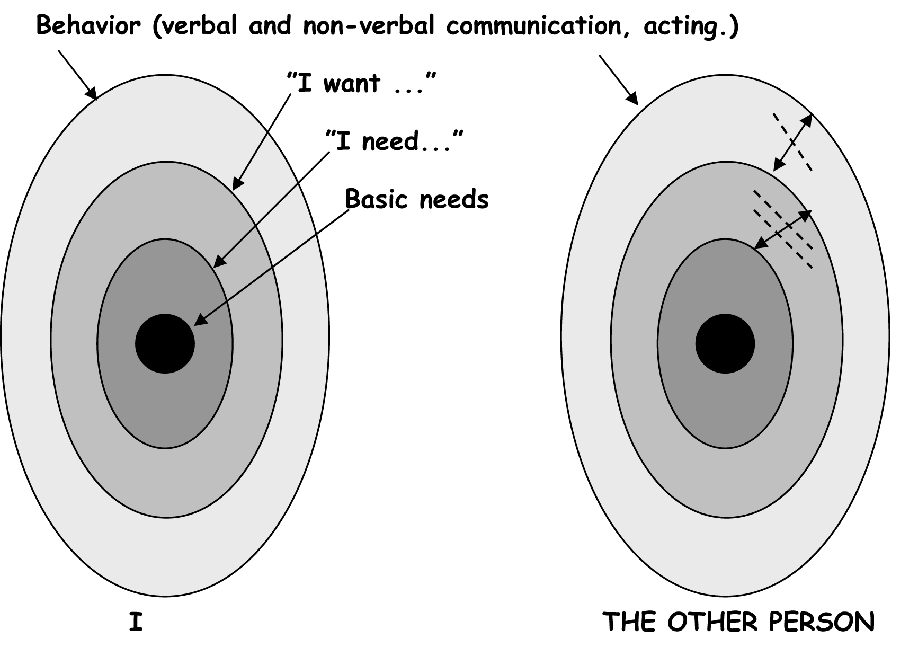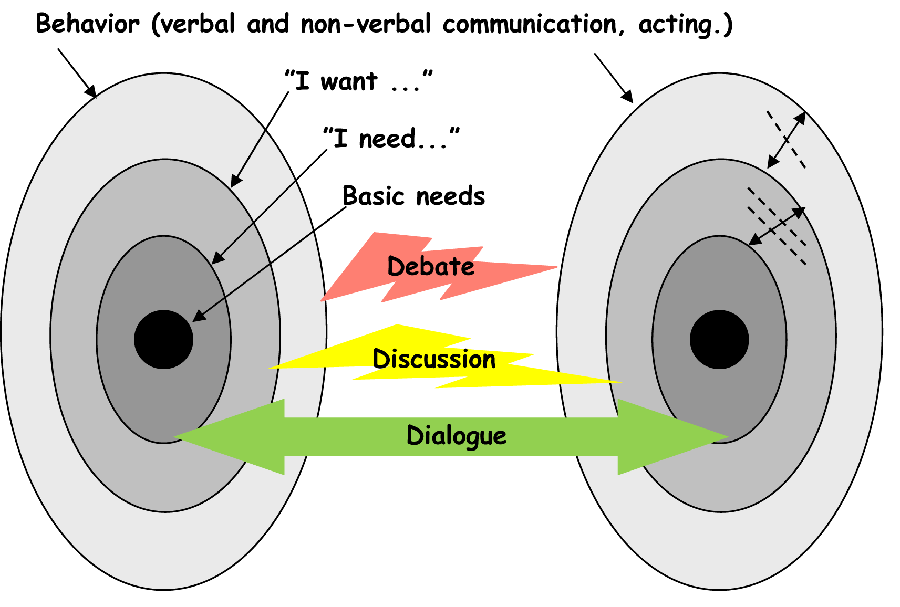

BASIC COMMUNICATION - 1: The Onion
THE ONION
A psychological model of our psyche.Index of content:
1. The Onion.
2. Emotions
3. Step I:_ Conscious Presence.
4. Step II:_Two different realities.
5. Step III: The third reality.
6. Basic communication.
7. Basic Listening.
8. Basic Negotiation.
9. Directed Advice
10. Summary
- A model of communication.
- Why do we have emotions?
- Creating contact and trust.
- Creating clarity.
- Verbalizing the unexpressed.
- Summary - a new structure.
- How can I make others be clear?
- A structure for good co-operation.
- Don't assume mind reading, speak out.
- Communicate - relate.Communication - not only the words
Communication is not only what we say. It is the sum of everything visible that we do, our total behavior. Our spoken language constitutes, information-wise in a normal conversation, just a few percent of everything we communicate.
When misunderstandings occur (the most common cause of conflicts), this happens partly because one speaks unclearly, or because we sometimes put different meaning into words,
and partly because one's verbal and non-verbal communication do not correspond.We may sometimes be tempted to believe that the purpose of communicating is to express what we intend to communicate. When the other person then misunderstands, we may then exclaim "but you should have understood that!" - we act as if we think the other person should be able to mind-read ...
A more useful attitude can be:The meaning of my communication is the response I get.
If I do not get the response I hoped for, it is probably because I have not adjusted my communication to the other person. This may apply to many things in my communication, not only which words I use but also to how I communicate, both verbally and non-verbally.
If I adopt this attitude, my reaction to misunderstandings will be to adjust my communication until I get the response I want to have. With other words:The responsibility for whether my communication works is my own to 100% !
How I communicate is partly an expression of who I am as a person, of my core personality, but partly it is also a skill. A skill that in itself has nothing to do with my personality - it is a skill anyone can develop and refine.
The Onion Model
Before we go into how one can improve one's communication skills, a simple model of our psyche will be presented: "The Onion Model".
The model describes the different levels for action, thoughts and emotions.
The Onion Model, 11 minutes
The model describes the human being as "an onion", with many layers covering each other.
The outermost layer is the person's behavior. This includes what the person does, says, facial expressions, body posture, gestures, pattern of movement, breathing, etc.
Next layer is a mental level, and consists of the person's thoughts around "I want..."
As long as this is not expressed openly in words, this layer is hidden from me, even though I may have ideas and notions about this level.
The third level is the person's beliefs around "I need ...".
What the person needs is also hidden from me as long as it is not expressed, even though I may have thoughts about it.
The innermost core consists of Basic Needs. These are defined as needs of such a kind, that if they are not met at all over time, we will not survive. The most basic Basic Needs that self-evidently dictates physical survival are food, beverage and physical protection. But there are many other Basic Needs: love, to belong somewhere, meaningfulness, being seen and respected, being able to contribute, security, being able to control one's situation. If any of these are totally lacking, one will most probably become so depressed that the will to continue to stay alive will cease.
One can be consciously aware of all these levels, but one can also be completely unaware of one or more of the levels - one acts from subconscious triggers without being consciously aware of what one is doing or saying. One can be aware of what one wants, but one can also be subconsciously compelled by inner drives. One is seldom mentally aware of the levels "I need" and Basic Needs, but these levels although trigger emotions. More about this further down.
Independent of whether the levels are in or below conscious awareness, we often act as if the four levels are connected. A very common cause for unclear communication is the fact that they are not always connected. As is indicated in the schematic above, there are often "loose connections" - what I say does not correspond with what I really want.
What I say that I want does not correspond with what I really need.
Sometimes my behavior is controlled by one or more of "The Three P:s", a notation that we will come back to further down in this course. PPP represent things that I may want to have and that I may be prepared to fight for, but which have no connection with what I really am in need of. The three P:s stand for:
- Position - I know what I want and I'm not prepared to give it up..."
- Principles - "It is against my principles to do this..."
- Prestige-mindedness. (Self-explanatory...)
Communication Levels
The first level, the behavior, constitutes the only thing I really can know about another person - the levels below are hidden from me as long as they are not expressed verbally. I may have thoughts and conceptions about the lower levels, but as long as the person does not say anything about them, I don't know. Despite this we often act as if we are mind-readers, or as if the other person should be one...
If we limit our communication to be about what the other person says and/or does, the outcome will at best be a debate, at worst a conflict.
"But - you can't do it that way...", or "I can never accept what you are saying..."
One step in the right direction could be to include the next level in our communication: "What I really want doing this is...", or "What do you really want, saying that?"
But, if we limit our communication to what we and the other person say and do and what we want doing this, the outcome will at best be a discussion. And, as you may have experienced many times, a discussion can be OK, but it can also continue eternally...
If I on the other hand in my communication include what I really need, and in an active way try to figure out what the other person needs in whatever we are talking about, then we can achieve a communication that represents a dialogue:
How do you create dialogue?
What up to now has been presented may give you knowledge about how we function and that we would benefit from including more levels than the Behavior level in our communication. This has hopefully led to the insight that our communication can be made to work better.
But, the insight that it might be so gives so far way too few clues about how this should be done. How do you create or facilitate dialogue?
This course will focus on this, and a specific method, a specific communication pattern will be presented, a pattern that makes dialogue possible and that empowers it. This pattern differs in quite a radical way from our normal way of communicating, but it represents a skill, a skill that anyone can learn and train, until it becomes a subconscious and automatic habit.
But, before going into this,
we need to shed a little more light on the levels
"I need" and Basic Needs, which will be the topic of next section ->.




